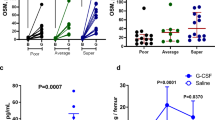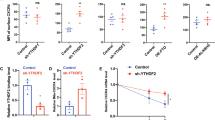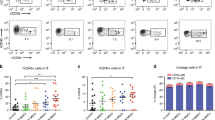Abstract
Efficient hematopoietic stem cell (HSC) homing is important for hematopoietic cell transplantation (HCT), especially when HSC numbers are limited, as in the use of cord blood (CB). In a screen of small-molecule compounds, we identified glucocorticoid (GC) hormone signaling as an activator of CXCR4 expression in human CB HSCs and hematopoietic progenitor cells (HPCs). Short-term GC pretreatment of human CB HSCs and HPCs promoted SDF-1–CXCR4-axis-mediated chemotaxis, homing, and long-term engraftment when these cells were transplanted into primary- and secondary-recipient NSG mice. Mechanistically, activated glucocorticoid receptor binds directly to a glucocorticoid response element in the CXCR4 promoter and recruits the SRC-1–p300 complex to promote H4K5 and H4K16 histone acetylation, facilitating transcription of CXCR4. These results suggest a new and readily available means to enhance the clinical efficacy of CB HCT.
This is a preview of subscription content, access via your institution
Access options
Access Nature and 54 other Nature Portfolio journals
Get Nature+, our best-value online-access subscription
$29.99 / 30 days
cancel any time
Subscribe to this journal
Receive 12 print issues and online access
$209.00 per year
only $17.42 per issue
Buy this article
- Purchase on Springer Link
- Instant access to full article PDF
Prices may be subject to local taxes which are calculated during checkout


Similar content being viewed by others
References
Doulatov, S., Notta, F., Laurenti, E. & Dick, J.E. Cell Stem Cell 10, 120–136 (2012).
Ballen, K.K., Gluckman, E. & Broxmeyer, H.E. Blood 122, 491–498 (2013).
Fares, I. et al. Science 345, 1509–1512 (2014).
Boitano, A.E. et al. Science 329, 1345–1348 (2010).
Wagner, J.E. Jr. et al. Cell Stem Cell 18, 144–155 (2016).
Morrison, S.J. & Scadden, D.T. Nature 505, 327–334 (2014).
Peled, A. et al. Science 283, 845–848 (1999).
Capitano, M.L. & Broxmeyer, H.E. Encyclopedia of Cell Biology 3, 624–631 (2016).
Christopherson, K.W., II, Hangoc, G., Mantel, C.R. & Broxmeyer, H.E. Science 305, 1000–1003 (2004).
Hoggatt, J., Singh, P., Sampath, J. & Pelus, L.M. Blood 113, 5444–5455 (2009).
Chaurasia, P., Gajzer, D.C., Schaniel, C., D'Souza, S. & Hoffman, R. J. Clin. Invest. 124, 2378–2395 (2014).
Gul, H. et al. Stem Cells Dev. 18, 831–838 (2009).
Capitano, M.L., Hangoc, G., Cooper, S. & Broxmeyer, H.E. Stem Cells 33, 1975–1984 (2015).
Högger, P. & Rohdewald, P. Steroids 59, 597–602 (1994).
Broxmeyer, H.E. et al. J. Exp. Med. 201, 1307–1318 (2005).
Kadmiel, M. & Cidlowski, J.A. Trends Pharmacol. Sci. 34, 518–530 (2013).
Watson, L.C. et al. Nat. Struct. Mol. Biol. 20, 876–883 (2013).
McKenna, N.J. & O'Malley, B.W. Cell 108, 465–474 (2002).
Lonard, D.M. & O'malley, B.W. Mol. Cell 27, 691–700 (2007).
Eberharter, A. & Becker, P.B. EMBO Rep. 3, 224–229 (2002).
Acknowledgements
We thank other members in the Broxmeyer laboratory for helpful discussion and assistance and A.L. Sinn from the In vivo Therapeutics Core of the Indiana University School of Medicine for transplantation assistance. This work was supported by US Public Health Service Grants from the NIH to H.E.B. (R01 HL112669, R01 HL056416, U54 DK106846).
Author information
Authors and Affiliations
Contributions
B.G. and H.E.B. conceived the research, designed and performed experiments, interpreted data, and wrote the manuscript. X.H. and S.C. performed intravenous injection and interpreted data.
Corresponding author
Ethics declarations
Competing interests
H.E.B. is a member of the Medical Scientific Advisory Board of CordUse, a cord blood banking company based in Orlando, Florida.
Supplementary information
Supplementary Figures and Tables
Supplementary Figures 1–4 and Supplementary Tables 1–3 (PDF 3290 kb)
Rights and permissions
About this article
Cite this article
Guo, B., Huang, X., Cooper, S. et al. Glucocorticoid hormone-induced chromatin remodeling enhances human hematopoietic stem cell homing and engraftment. Nat Med 23, 424–428 (2017). https://doi.org/10.1038/nm.4298
Received:
Accepted:
Published:
Issue Date:
DOI: https://doi.org/10.1038/nm.4298
This article is cited by
-
Transient regulation of RNA methylation in human hematopoietic stem cells promotes their homing and engraftment
Leukemia (2023)
-
Nuclear Tubulin Enhances CXCR4 Transcription and Promotes Chemotaxis Through TCF12 Transcription Factor in human Hematopoietic Stem Cells
Stem Cell Reviews and Reports (2023)
-
Impact of Betamethasone Pretreatment on Engrafment of Cord Blood-Derived Hematopoietic Stem Cells
Archivum Immunologiae et Therapiae Experimentalis (2023)
-
Pharmacological activation of nitric oxide signaling promotes human hematopoietic stem cell homing and engraftment
Leukemia (2021)
-
RXR Negatively Regulates Ex Vivo Expansion of Human Cord Blood Hematopoietic Stem and Progenitor Cells
Stem Cell Reviews and Reports (2021)



